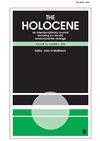中美洲北部前古典主义晚期的古环境研究
IF 1.8
3区 地球科学
Q3 GEOGRAPHY, PHYSICAL
引用次数: 0
摘要
中美洲北部边境是一个复杂的多文化地区,其特点是前古典主义晚期(约公元前400年至公元前150年)人类定居频繁变化,农业条件发生变化。在这里,我们报告了一份高分辨率的古环境记录,该记录来自maar La Alberca火山口的可变沉积序列,该序列跨越了前古典晚期(约公元前400年至公元前150年)到对应于Chupicuaro晚期(约前400年-公元前100年)和Mixtlan期(0–250年)的早期古典期(约150年至公元后250年)。我们的工作旨在研究中美洲北部边境农业兴起期间的古环境条件,并提供与人类活动造成的景观变化有关的见解。为了实现这些目标,通过变异计数、高分辨率XRF扫描、磁化率、花粉数据和粪便锡醇生物标志物作为人类种群变化的指标,进行了一项多基因研究。我们的结果揭示了两种变异型。类型1的特征是碎屑有机层和霰石层的交替,类型2的特征是将碎屑有机层与由硅藻截头体和霰石形成的有机层交替。这项研究表明,在Chupicuaro晚期(公元前400年至公元前100年)和Mixtlan期开始(0–250年),人类活动造成的侵蚀增加,与苋科花粉的高百分比、沉降速率的上升、营养成分的增加以及用(Coprostanol)解释的人类排泄物流量的增加相一致 + 表):(Coprostanol + epi)+胆甾烷醇生物标志物。此外,Chupiacuaro晚期和Mixtlan期开始期间的湿润期(约公元前137年至公元前37年)可能为农业的建立提供了有利的环境条件。本文章由计算机程序翻译,如有差异,请以英文原文为准。
Paleoenvironmental study of the Late Preclassic period in the Northern Mesoamerican Frontier
The Northern Mesoamerican Frontier was a complex multicultural region characterized by frequent human settlement changes and shifts in agricultural conditions during the Late Preclassic period (~400 BCE-150 CE). Here, we report a high-resolution paleoenvironmental record from the varved sedimentary sequence of the crater maar La Alberca which spans the Late Preclassic (~400 BCE-150 CE) to part of the Early Classic period (~150 CE-250 CE) corresponding to Late Chupicuaro phase (400 BCE-100 CE) and Mixtlan phase (0–250 CE). Our work aims to study the paleoenvironmental conditions during the rise of agriculture in the Northern Mesoamerican Frontier and provide insights related to landscape alteration by human activity. To reach these aims, a multiproxy investigation was conducted by means of varve counting, high-resolution XRF scans, magnetic susceptibility, pollen data and fecal stanol biomarkers as a proxy for human population change. Our results reveal two varve type. Type 1 is characterized by the alternation of detrital-organic layers and aragonite layers, type 2 by alternating detrital-organic layers with an organic layer formed by diatom frustules and aragonite layers. This study suggest that the increase of erosion by human activity during the Late Chupicuaro phase (400 BCE-100 CE) and the start of the Mixtlan phase (0–250 CE) coincide with a high percentage of Amaranthaceae pollen, a rise of sedimentation rates, increase in nutrient content and the increase of human waste flux interpreted with the (Coprostanol + epi) :((Coprostanol + epi)+cholestanol biomarker. Moreover, a wetter period (~137 BCE-37 CE) interpreted during the Late Chupiacuaro phase and the start of the Mixtlan phase could suggest favorable environmental conditions for the establishment of agriculture.
求助全文
通过发布文献求助,成功后即可免费获取论文全文。
去求助
来源期刊

Holocene
地学-地球科学综合
CiteScore
4.70
自引率
8.30%
发文量
106
审稿时长
4 months
期刊介绍:
The Holocene is a high impact, peer-reviewed journal dedicated to fundamental scientific research at the interface between the long Quaternary record and the natural and human-induced environmental processes operating at the Earth''s surface today. The Holocene emphasizes environmental change over the last ca 11 700 years.
 求助内容:
求助内容: 应助结果提醒方式:
应助结果提醒方式:


